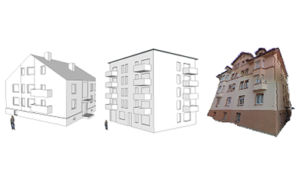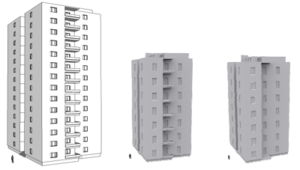Nowadays, we increasingly deal with navigation systems to find our way to unknown places, or have a look at digital maps or street views to get a first impression of places we have never been before. In addition, we consume 3D city scenes in computer games or movies. As the computational hardware and software conditions are constantly improving, the applications and their underlying building models do with increasing geometric complexity and detailed textures.
What Details do we Need to Recognize 3D Buildings?
But by creating new systems that use virtual city models, we always have to keep one question in mind: What kind of representations do we really need to understand the inherent information? Depending on the application, we need a different level of detail for the transmitted data. For example, in computer games we expect to have realistic graphics, while in navigation systems abstract images are sufficient for the orientation and wayfinding. Thereby we can hold the balance between efficient use of the available computing capacity and the required digital representation to understand what is shown. But what are the visual elements, that are essential for us to recognize buildings in a virtual 3D city?
Within our research we want to get a deeper understanding of the human’s cognitive experience of virtual 3D cities. For this purpose we conduct user studies. Our latest study reveals various dependencies between the geometry of 3D models and the perceptibility of the building categories. Which geometries are relevant to perceive a specific building category, for example a building with shops, a multi-family house or an office building?
In this user study we learned, that in general textural information significantly helps users to classify buildings to the correct category, especially when dealing with complex building categories like building with shops or office buildings. On the other hand, building categories that are clearly separable from the rest like one-family buildings, an untextured representation is sufficient. For untextured buildings, the correct classification mainly depends on properties learned to be perceptually relevant for the respective building category. One example for such perceptually relevant geometries and structures is the occurrence of balconies for residential towers.
The research results of this user study were recently presented at the International Society for Photogrammetry and Remote Sensing (ISPRS) Congress in Prague.The full paper is available on http://dx.doi.org/10.5194/isprs-archives-XLI-B2-683-2016/ .
We Aim to Develop Methods to Generate Graphics for Different Applications
In further studies we want to investigate the classification results based on building models presented to the user in a 3D environment. Subsequently, we want to investigate which influence the surroundings have on classifying a building to a specific category. For that purpose, the users will be faced with the architectural environment of the building of interest. We want to use the knowledge derived in our user studies to develop algorithms that automatically generate and modify suitable building representations for different types of applications.
In our current study users interact with the models and are additionally faced with the architectural environment of the building of interest to recognize the category of the buildings.
You are Invited to Participate in our Current Online Study!
We would be pleased to receive your support for our research project by taking part in our on-going survey. To start it, open the following link: https://goo.gl/forms/4giyaUD1Kkdah6lx1.
If you have questions regarding the study or the procedure, you are free to aks or leave a comment.




